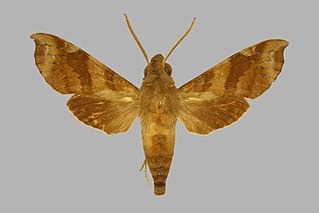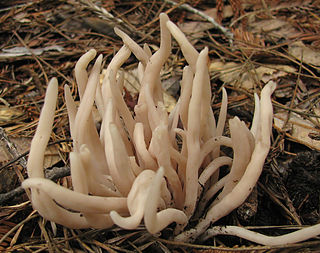
Puffballs are a type of fungus featuring a ball-shaped fruit body that bursts on contact or impact, releasing a cloud of dust-like spores into the surrounding area. Puffballs belong to the division Basidiomycota and encompass several genera, including Calvatia, Calbovista and Lycoperdon. The puffballs were previously treated as a taxonomic group called the Gasteromycetes or Gasteromycetidae, but they are now known to be a polyphyletic assemblage.

The smoky white-toothed shrew is a species of mammal in the family Soricidae. It is endemic to Kenya. Its natural habitat is subtropical or tropical moist montane forests.

Aseptis fumosa is a moth of the family Noctuidae first described by Augustus Radcliffe Grote in 1879. It is widespread in western North America and is known from western Canada, Washington, Nebraska, Colorado, Utah, Arizona, Nevada and California. It occurs in a variety of diverse habitats including coast chaparral, dry conifer forest, and shrub steppe.

Drasteria fumosa, the smoky arches, is a species of moth in the family Erebidae first described by Strecker in 1898. It is found from the US state of California east to Utah and Texas.

Temnora fumosa is a moth of the family Sphingidae. It is found in most habitats throughout Africa south of the Sahara.

Clavaria fumosa, commonly known as the grayish fairy club, smoky clavaria or smoky spindles, is a species of coral fungus in the family Clavariaceae. It was originally described by Christian Hendrik Persoon in 1795.
Thermoniphas fumosa, the smoky chalk blue, is a butterfly in the family Lycaenidae. It is found in Nigeria, Cameroon, Gabon, the Republic of the Congo, the Central African Republic and the Democratic Republic of the Congo (Mayumbe). The habitat consists of clearings in submontane forests and lowland forests.
Serixia is a genus of longhorn beetles of the subfamily Lamiinae, containing the following species:
Serixia buruensis is a species of beetle in the family Cerambycidae. It was described by Stephan von Breuning in 1958.
Serixia cinereotomentosa is a species of beetle in the family Cerambycidae. It was described by Stephan von Breuning in 1958.
Serixia novaebritanniae is a species of beetle in the family Cerambycidae. It was described by Stephan von Breuning in 1958.
Serixia literata is a species of beetle in the family Cerambycidae. It was described by Francis Polkinghorne Pascoe in 1858. It is known from Malaysia, Borneo and Sulawesi.
Serixia longicornis is a species of beetle in the family Cerambycidae. It was described by Francis Polkinghorne Pascoe in 1858.
Serixia prolata is a species of beetle in the family Cerambycidae. It was described by Francis Polkinghorne Pascoe in 1858.
Serixia sedata is a species of beetle in the family Cerambycidae. It was described by Francis Polkinghorne Pascoe in 1862.
Serixia phaeoptera is a species of beetle in the family Cerambycidae. It was described by Per Olof Christopher Aurivillius in 1927.
Serixia nigroapicalis is a species of long horn beetle in the family Cerambycidae. It was described by Per Olof Christopher Aurivillius in 1927. This species is also part of the genus Serixia, order Coleoptera, class Insecta, phylum Arthropoda, and kingdom Animalia. These beetles can drill into wood and cause damage to live wood.
Paravilla fumosa is a species of bee flies.
Melocosa fumosa is a species of wolf spider in the family Lycosidae. It is found in the United States and Canada.
Allocapnia fumosa is a stonefly in the family Capniidae. It is commonly known as the Smokies snowfly and is found in the Eastern United States, including North Carolina, Tennessee, and Virginia. It is found in the Great Smoky Mountains, and its species name is Latin for "smoky."





